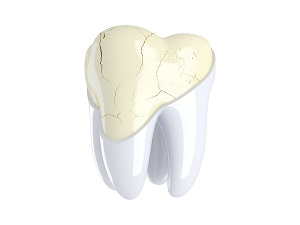 There are several different types of cracks that teeth can develop and they have a wide variety of symptoms. The most common symptom that you may have a tooth that is cracked is unpredictable pain with chewing especially with the release of the biting pressure. Some patients experience pain with hot or cold, while others may continue to only have occasional biting sensitivity. In many cases, the pain is very episodic and can refer to other areas of the mouth, which may make it difficult for the patient and the dentist, to determine which tooth is the source of the discomfort.
There are several different types of cracks that teeth can develop and they have a wide variety of symptoms. The most common symptom that you may have a tooth that is cracked is unpredictable pain with chewing especially with the release of the biting pressure. Some patients experience pain with hot or cold, while others may continue to only have occasional biting sensitivity. In many cases, the pain is very episodic and can refer to other areas of the mouth, which may make it difficult for the patient and the dentist, to determine which tooth is the source of the discomfort.
Because there are various types of cracked teeth and the severity of the crack determines which treatment is best for the patient.
- A cracked tooth implies that a crack in the hard, exterior portion of the tooth has extended internally. If the crack does not affect the pulp, then a crown will be needed to save the tooth. If the pulp is affected, then a root canal procedure and a crown will be necessary. If the crack extends past the pulp and into the root structure below the bone, then the tooth should, in most cases, be removed.
- A split tooth is often the result of a long-standing crack that was never treated and therefore creates distinct segments that can be separated. The tooth cannot be saved intact, but depending on the position of the crack, a portion of the tooth may be saved with a root canal procedure.
A vertical root fracture is one that starts in the root structure and extends toward the chewing surface. These teeth rarely show symptoms and therefore, can sometimes go unnoticed until the surrounding gum tissue and bone become infected. The majority of these teeth must be extracted due to the prolonged progression of disease by the time the issue is discovered.
A cracked tooth does not only affect the surface. Several layers of a tooth can be victims of the crack, depending on the size. Under the outer, hard, white layer of enamel, is a softer substance called dentin and inside of that, is the dental pulp, which contains the nerves and blood vessels and is what is removed during a root canal procedure. A cracked tooth is painful because when the outer hard tissues of the tooth are cracked, chewing on it can cause the pieces to move which can irritate the pulp. Eventually the repeated stress on the pulp will damage it irreparably. This will lead eventually to is death and infection to the tooth, and possibly the surrounding gum and bone.
Unfortunately, cracks in teeth do not heal; even when treated, they may continue to progress and separate, which may result in the loss of the tooth. Placing a crown on a cracked tooth is the best way to provide maximum protection, but is no guarantee that the treatment will be successful, long-term. However, once these teeth are treated properly and in a timely fashion, they can continue to function for a lifetime.
Cracking a tooth may not always be preventable, but there are some things that you can do to help make your teeth less susceptible to cracks.
- Avoid chewing on extremely hard objects, such as ice, popcorn kernels that are unpopped, hard candy or other extremely hard objects.
- Avoid clenching or grinding your teeth if you are aware.
- If you clench or grind your teeth at night when it is impossible to control, discuss a professional night guard or retainer with your dentist.
- Always wear a protective guard when engaging in contact sports.
The overall outcome for the tooth, and the type of treatment necessary to help save it, varies, depending on type, location and extent of the crack. If a patient is concerned that they may have a cracked tooth, it is imperative to see your endodontist (this is someone who specializes in saving cracked teeth) as soon as possible. The more time that passes without treatment, the greater the risk of the fracture growing in size and spreading into the root, which would necessitate an extraction of the tooth.
